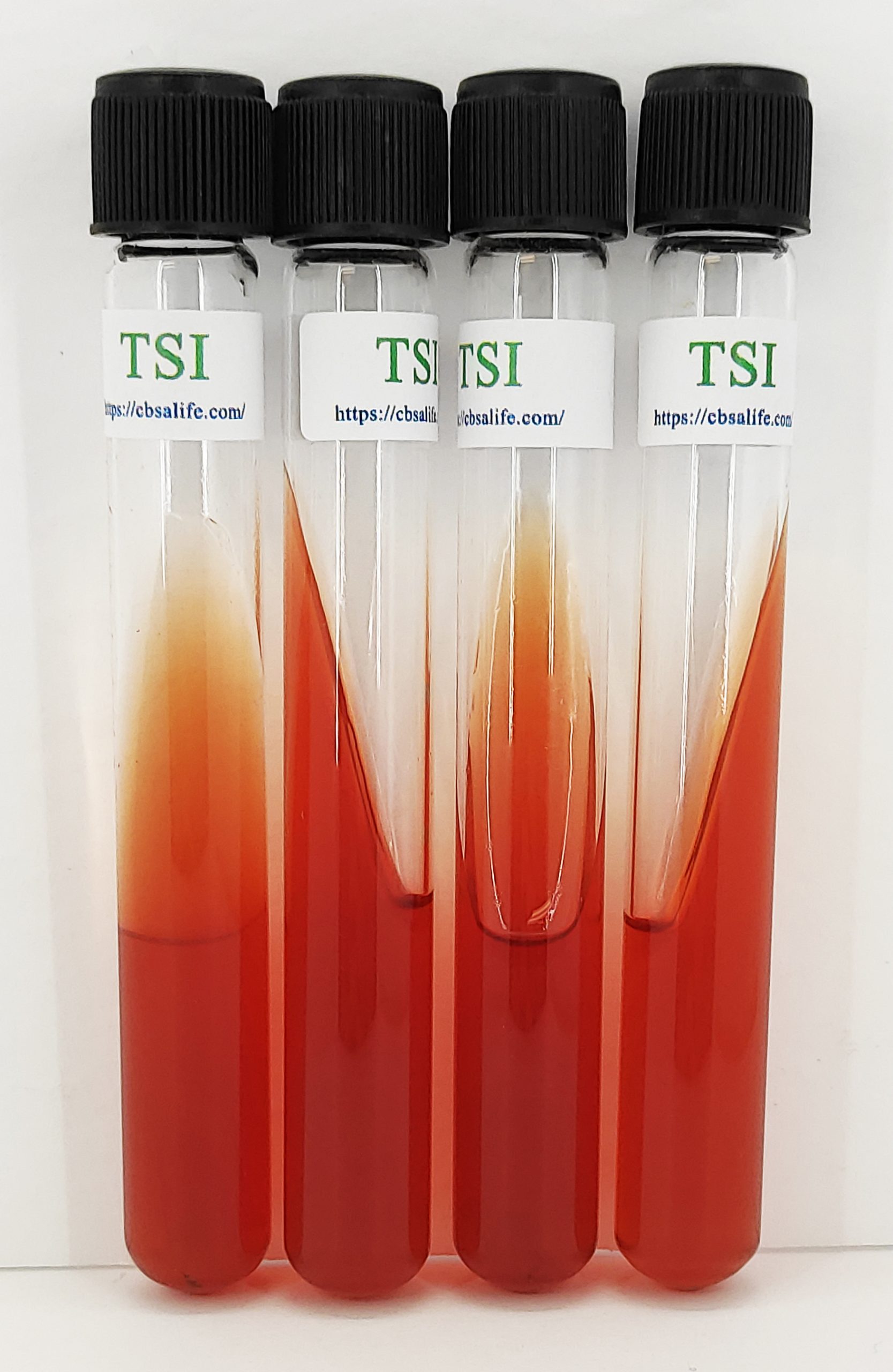Most bacteria have the ability to ferment carbohydrates, especially sugars. Usually, each bacterium can only ferment some sugars. Therefore, the sugars that a bacterium can ferment and the sugars it cannot are characteristic of that bacterium and therefore an important criterion for its identification. Triple Sugar Iron (TSI) agar is a culture medium that, due to its ability to test the ability of a microorganism to ferment sugars and produce hydrogen sulfide,This species is named.
Capabilities of TSI culture medium for differentiation of different bacteria
TSI culture medium for investigation
- Glucose fermentation
- lactose fermentation (milk sugar)
- Production of carbon dioxide gas (CO 2 )
- Production of hydrogen disulfide gas (H 2 S)
is used
Compositions of TSI agar culture medium
Casein pancreatic juice (15 g/L), lactose (10 g/L), sucrose (10 g/L), sodium chloride (5 g/L), animal tissue digesting peptic (5 g/L), yeast extract (3 g/L), beef extract (3 g/L), dextrose (1 g/L), ferric ammonium citrate (0.5 g/L), sodium thiosulfate (0.3 g/L), phenol red (0.024 g/L) ) and agar (12 g/liter).
The final pH of this culture medium at 25°C is equal to 7.3±0.2.
The basis of TSI agar culture medium
- TSI agar is a special multi-sugar medium containing a pH-sensitive dye (phenol red), 1% lactose, 1% sucrose, 0.1% glucose, as well as sodium thiosulfate and ferrous sulfate or ferrous ammonium sulfate.
- When all of these materials are mixed together and allowed to solidify at an angle, a slanted agar test tube is created.
- The oblique shape of this environment provides a series of surfaces that are either exposed to varying degrees of oxygen-containing air (aerobic environment) or not exposed to air (anaerobic environment) under which the fermentation patterns of living organisms are determined.
- TSI agar medium is designed to differentiate between microorganisms based on differences in their patterns of carbohydrate fermentation and hydrogen sulfide production.
- Carbohydrate fermentation is indicated by the production of gas and the color of the pH indicator changing from red to yellow.
- Due to acid formation during fermentation, the pH decreases. The acid-base indicator phenol red exists to detect carbohydrate fermentation in the environment, and fermentation is detected by changing the color of the carbohydrate medium from red-orange to yellow in the presence of acids.
- In the case of oxidative decarboxylation of peptone, alkaline products are formed and the pH increases. This is indicated by a change in the color of the environment from red-orange to dark red.
- Sodium thiosulfate and iron ammonium sulfate present in the TSI culture medium detect the production of hydrogen sulfide and are indicated by the black color on the edge of the tube.
- To facilitate the identification of organisms that ferment only glucose, the concentration of glucose is one-tenth that of lactose or sucrose.
- The small amount of acid produced in the tube slope during glucose fermentation is rapidly oxidized, causing the medium to remain red-orange in color or return to an alkaline pH. In contrast, the acidic reaction (yellow) is maintained at the edge of the tube because it is under lower oxygen tension.
- Once the limited glucose is exhausted, organisms that are able to do so begin to use lactose or sucrose.
How to interpret and identify in TSI agar culture medium
- Alkaline/Acid Reaction (Red Slope/Yellow Depth): This reaction is indicative of dextrose fermentation only.
- Acid/acid reaction (yellow slope/yellow depth): indicates the fermentation of dextrose, lactose or sucrose.
- Alkaline/alkaline reaction (red slope, red depth): no carbohydrate fermentation.
- Deep blackening of the environment: occurs in the presence of hydrogen gas.
- Gas production: Bubbles or cracks in agar indicate gas production (formation of CO 2 and H 2 ).
Uses of trisugar iron agar (TSI) culture medium
- It is used to determine an organism's ability to ferment glucose, lactose, and sucrose and their ability to produce hydrogen sulfide.
- It is mainly used to distinguish members of the Enterobacteriaceae family from other Gram-negative rods.
- It is also used to differentiate between Enterobacteriaceae based on their sugar fermentation patterns.
Limitations of TSI agar culture medium
- It is recommended to perform biochemical, immunological, molecular or mass spectrometry tests on colonies obtained from pure culture for complete identification.
- It is important that the stabbing process is done for this method and if this does not happen, the test results will lose their validity. In brief, the stabbing process consists of removing the bacteria from the agar with a loop or needle tip and inserting it deep into the agar. It is also important that the agar does not lose its monolithic structure during the stabilization process. Caps must be loosened while performing this test or erroneous results will occur.
- TSI agar should be read during the 18-24 hour incubation period. If read too soon, a false positive reaction may be observed. If read after 24 hours, a false negative reaction may be observed.
- An organism that produces hydrogen sulfide may mask acid production at the bottom of the environment. However, the production of hydrogen sulfide requires an acidic environment, so the butt portion should be considered acid.
- TSI is not sensitive in detecting hydrogen sulfide compared to other iron-containing media, such as indole sulfide medium (SIM).
- Certain species or strains may develop delayed reactions or completely fail to ferment carbohydrates in the manner described.

